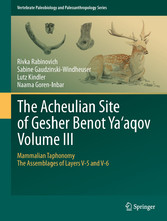Suchen und Finden
The Acheulian Site of Gesher Benot Ya'aqov Volume III - Mammalian Taphonomy. The Assemblages of Layers V-5 and V-6
Mehr zum Inhalt

The Acheulian Site of Gesher Benot Ya'aqov Volume III - Mammalian Taphonomy. The Assemblages of Layers V-5 and V-6
Multidisciplinary research on the Early-Middle Pleistocene site of Gesher Benot Ya'aqov has yielded abundant climatic, environmental, ecological and behavioral records. The 15 archaeological horizons form a sequence of Acheulian occupational episodes on the shore of the paleo-Lake Hula. These enable us to reconstruct numerous aspects of the survival and adaptation of ancient hominins, leading to a better understanding of their evolution and behavior. This book presents the faunal analyses of medium-sized and large mammals, providing taxonomic, taphonomic and actualistic data for the largest faunal assemblages. The study of modes of animal exploitation reveals valuable information on hominin behavior.
Dr. Rivka Rabinovich is a lecturer at the Institute of Archaeology, Institute of Earth Sciences and the Academic Curator of the paleobiological collections of the Hebrew University. Her research has been focused on the faunal assemblages, mainly mammals from Pleistocene localities; attempting to discern between the human-related patterns of collecting fauna, such as dietary practices and cultural traditions, to environmental factors, such the sedimentary setting and changing of climatic conditions.
Univ. - Prof. Dr. Sabine Gaudzinski-Windheuser is Professor at the Institute for Pre- and Protohistoric Archaeology at the Johannes Gutenberg-University, Mainz, Germany and Head of the Palaeolithic Research Unit of the Römisch-Germanisches Zentralmuseum at Neuwied, Germany. Her main research is Pleistocene and Early Holocene Archaeology and Archaeozoology. She is the author of numerous articles and books on hominin subsistence behaviour and ecology in Europe and the Southern Levant.
Dr. Lutz Kindler is research assistant at the Palaeolithic Research Unit of the Römisch-Germanisches Zentralmuseum at Neuwied, Germany and lecturer for bioarchaeology at the Institute for Pre- and Protohistoric Archaeology at the Johannes Gutenberg-University, Mainz, Germany. His research focuses on the ecology and economy of Pleistocene hominins, actualistic studies of biostratinomic processes and the reconstruction of taphonomic histories of archaeofaunas. His PhD dealt with the Middle Paleolithic fauna of the Balve Cave in Germany and examined the role of carnivores in the subsistence and ecology of late Pleistocene Neanderthals.
Prof. Naama Goren-Inbar is a professor at the Institute of Archaeology, the Hebrew University of Jerusalem. Her main research interest is the prehistory of the Levant, including technological, cultural, and behavioral aspects of ancient hominins at their environment. Her stuides and the research team she directs are one of the leading landmarks in the Prehistoric Archaeology of the Southern Levant. She is the author of numerous articles, several books and a leading scholar in the synergic attempts to reconstruct the Levantine Pleistocene.
Alle Preise verstehen sich inklusive der gesetzlichen MwSt.







